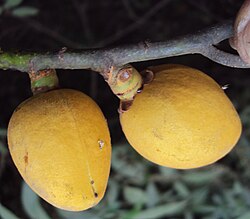Note: This is a project under development. The articles on this wiki are just being initiated and broadly incomplete. You can Help creating new pages.
Myristica dactyloides - Jatiphala
Jatiphala is a large evergreen tree found in the wet forests of the western ghats in south India and Sri Lanka. It is closely related to the nutmeg tree.
Contents
[hide]- 1 Uses
- 2 Parts Used
- 3 Chemical Composition
- 4 Common names
- 5 Properties
- 6 Habit
- 7 Identification
- 8 List of Ayurvedic medicine in which the herb is used
- 9 Where to get the saplings
- 10 Mode of Propagation
- 11 How to plant/cultivate
- 12 Commonly seen growing in areas
- 13 Photo Gallery
- 14 References
- 15 External Links
Uses
Asthma, Bad breath, Excessive thirst, Irritable bowel syndrome, Indigestion, Aphrodisiac, Cough, Cold, Diarrhea, Skin problems [1]
Parts Used
Chemical Composition
Beta pipene, alpha terpinene, safrole, methyl eugenol, myristicin, trimyristin, dihydro-dioeugeneol, myristic acid, epicatechin, cyanadin, nectandrin-B, Verrucosin, lignans and neolignans etc.[2]
Common names
| Language | Common name |
|---|---|
| Kannada | Kaadu jaapatre, Kadu jaajikaai, Kadu pindi kayi |
| Hindi | Jaiphal |
| Malayalam | Adakkappayin, Panthappayin |
| Tamil | Catikkaymaram, Kattuc catikkay |
| Telugu | Adavijaajikaaya |
| Marathi | NA |
| Gujarathi | NA |
| Punjabi | NA |
| Kashmiri | NA |
| Sanskrit | Jatiphala, Malatiphala |
| English |
Properties
Reference: Dravya - Substance, Rasa - Taste, Guna - Qualities, Veerya - Potency, Vipaka - Post-digesion effect, Karma - Pharmacological activity, Prabhava - Therepeutics.
Dravya
Rasa
Tikta (Bitter), Katu (Pungent)
Guna
Laghu (Light), Teekshna (Piercing, strong, penetrative)
Veerya
Sheeta (Cold)
Vipaka
Katu (Pungent)
Karma
Kapha, Pitta
Prabhava
Habit
Identification
Leaf
| Kind | Shape | Feature |
|---|---|---|
| Simple | Alternate | Leaves simple, alternate, distichous, 12-25 x 4-10 cm, oblong or elliptic-ovate, apex acute, base acute, round or rarely cuneate, margin entire, glabrous, shining above and glaucous beneath, coriaceous |
Flower
| Type | Size | Color and composition | Stamen | More information |
|---|---|---|---|---|
| Unisexual | 7-15 | Male flowers 10-20 together in short axillary dense clusters, female flowers as in male, generally 3-4 in the heads |
Fruit
| Type | Size | Mass | Appearance | Seeds | More information |
|---|---|---|---|---|---|
| Capsule | 5-7.5 x 3.7-6 cm | Pericarp rufous pubescent when young, thick, succulent | Seed one, ovoid; aril orange red, encircling the seed, deeply cut down into many lobes, each lanceolate at the apex into filiform segments. | {{{6}}} |
Other features
List of Ayurvedic medicine in which the herb is used
Where to get the saplings
Mode of Propagation
How to plant/cultivate
Seed - dries out easily, loses its viability rapidly, and cannot be stored. [4]
Commonly seen growing in areas
Tropical area, Evergreen forest.
Photo Gallery
References
- Jump up ↑ Uses
- Jump up ↑ Illustrated Dravyaguna Vijnana, Vol.II by JLN Shastry.
- Jump up ↑ Botanic description
- Jump up ↑ Cultivation details
External Links
- Ayurvedic Herbs known to be helpful to treat Asthma
- Ayurvedic Herbs known to be helpful to treat Bad breath
- Ayurvedic Herbs known to be helpful to treat Excessive thirst
- Ayurvedic Herbs known to be helpful to treat Irritable bowel syndrome
- Ayurvedic Herbs known to be helpful to treat Indigestion
- Ayurvedic Herbs known to be helpful to treat Aphrodisiac
- Ayurvedic Herbs known to be helpful to treat Cough
- Ayurvedic Herbs known to be helpful to treat Cold
- Ayurvedic Herbs known to be helpful to treat Diarrhea
- Ayurvedic Herbs known to be helpful to treat Skin problems
- Herbs with Seeds used in medicine
- Herbs with common name in Kannada
- Herbs with common name in Hindi
- Herbs with common name in Malayalam
- Herbs with common name in Tamil
- Herbs with common name in Telugu
- Herbs with common name in Sanskrit
- Habit - Tree
- Herbs that are commonly seen in the region of Tropical area
- Herbs that are commonly seen in the region of Evergreen forest
- Herbs
- Plants of western ghats
- Trees
- Myristicaceae




